Don’t be out of tune on Ukraine
Claire Axelrad explains how fundraisers can help supporters contribute to solving the problems that matter to them – whether that be the war in Ukraine or another crisis. Claire also shares recent examples from charities who got it right. Have a read and see if you can pick up some tips on how to acknowledge pressing issues and engage with your donors.
- Written by
- Claire Axelrad
- Added
- April 21, 2022
Note: this article first appeared on Claire’s website here on March 14th 2022.
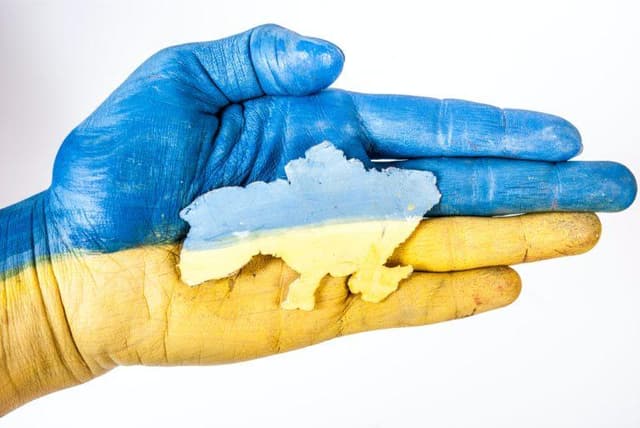
You’re acting out of tune when you fail to acknowledge that which is top of mind for your constituents.
At any point in time.
For the last couple of years, it was coronavirus. All the time.
At various points it was also a range of issues related to diversity, equity and inclusion, justice, law and order, or the lack thereof, individual rights and freedoms and, of course climate, including hurricanes, tornadoes, fires, and droughts.
Right now, it’s helping Ukraine and its people.
Whenever people are suffering, for whatever reason, it has a huge impact on the human psyche.
And when it’s in the news, that suffering, and impact is hugely amplified.
People want to stop the pain.
If you can help people do that, they will be grateful to you.
How can you help people now?
When it comes to helping people solve the problems that seem most urgent and pressing to them at this point in time, it matters what your current mission is and how you can relate it to what’s top of mind for folks.
What if you work in a related field?
You may not be based in Ukraine, or even do work internationally, but you might be involved in assisting people with legal or medical aid, basic human services like water, food and shelter, mental health and other supportive services, volunteer support, refugee resettlement, or even getting people the news they need to stay informed.
Talk about what you know, and how it relates to the current and imminent crisis.
Take this opportunity to showcase your authority and trustworthiness on the topic at hand. People are searching for how to help Ukrainians, but they don’t know who to trust. If you can show them a path forward, they will be appreciative.
Here’s one example from Jewish Family and Children’s Services (JFCS) of San Francisco, the Peninsula, Marin and Sonoma Counties (I served there as director of development and marketing for over two decades, and they still do one of the most effective jobs of branding I’ve seen anywhere). This is from their March e-newsletter.
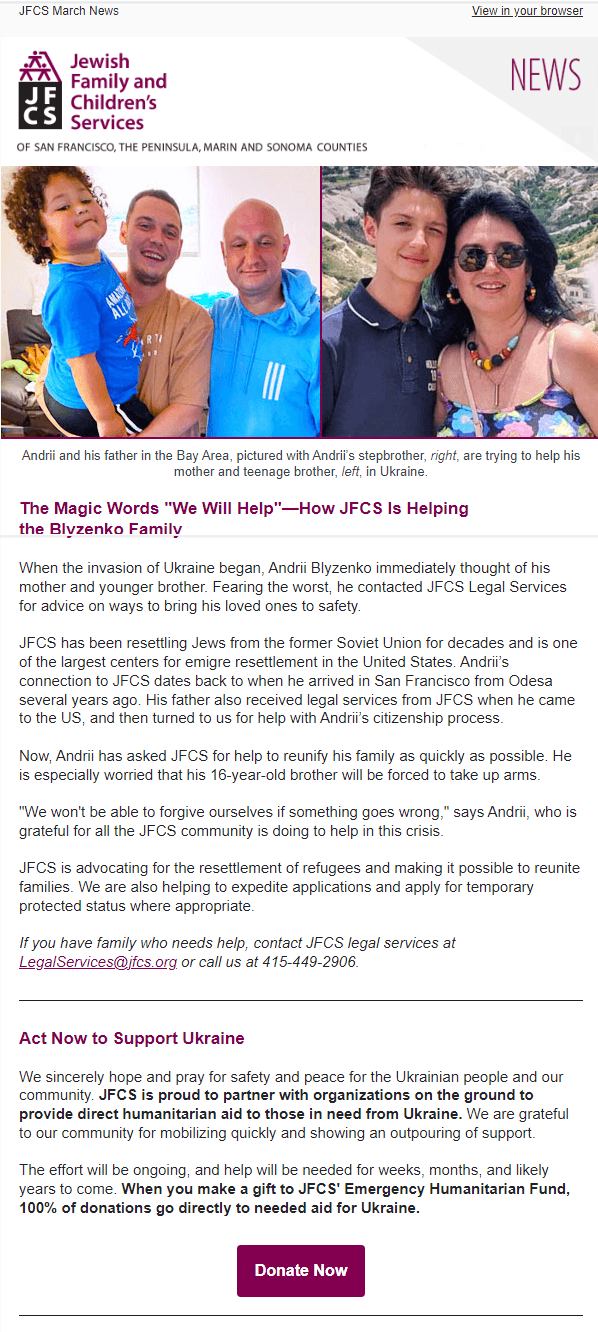
Here is what they get right:
- The email subject line is The Magic Words ‘We Will Help’. This is exactly what people want to do, so it hits folks where they are living.
- The photos of real people and storytelling caption: ‘Andrii and his father in the Bay Area, pictured with Andrii’s stepbrother, right, are trying to help his mother and teenage brother, left, in Ukraine’. Whenever you can manage to encapsulate everything you want to say in a photo and caption, that’s a good thing. Because sometimes people read nothing else.
- The copy relating the historic work of JFCS to today’s top-of-mind issue. They’ve been resettling Jews from the former Soviet Union for decades; some of those folks have family in Ukraine. Even if they can only help reunite one family right now (they describe specifically what they’re doing), it’s a step forward. They’re establishing their expertise, compassion, and authority.
- The direct call to action: ‘Act Now to Support Ukraine.’ The interesting part here is they are upfront about the fact they’re partnering with other ‘on-the-ground’ organisations. The donors may not have heard of these charities, but they’re likely to feel good about them because they already trust JFCS.
- The donate button. It’s always a good idea to have a button that stands out and makes giving, right now, easy. And when you click on that button, you’re taken to a page making it clear ‘100 per cent of donations go directly to needed aid for Ukraine.’
Here’s an example from Youth Service America, dedicated to activating young people as advocates, volunteers, supporters and fundraisers. This is from their March newsletter.
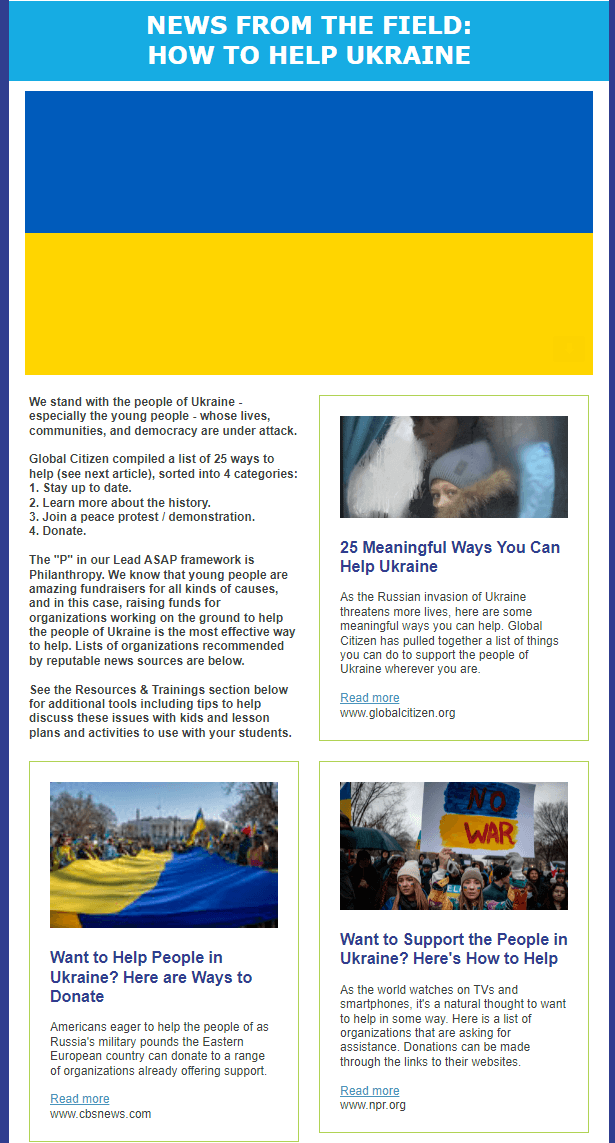
Here is what they get right:
- The image of the Ukrainian flag is eye-catching and on point. It’s been all over the news, so most people will know immediately what this article is likely related to.
- The copy ties back to their mission to galvanise youth as philanthropists. They make it clear they’ve done the research legwork and are sharing ways to help Ukraine.
- Links to other resources offering a variety of vetted ways to make an impact. They cite trusted sources of reporting, giving folks plenty of options. As a branding exercise, they make it clear YSA is the ‘go-to’ place for information about how to help in a crisis.
Here’s an example from National Public Radio (NPR). It showed up on their website early during the invasion and offers trusted ‘news’ – which is totally in keeping with their mission – about where to give. It’s been updated with more news explaining the invasion in detail. NPR isn’t directly providing human services, but they’re indirectly offering critical information and getting as close to helping with direct aid as possible by vetting other charities doing this critical work. It’s straightforward and clear in approach (for brevity, I included only three of nine suggested organisations in this image).
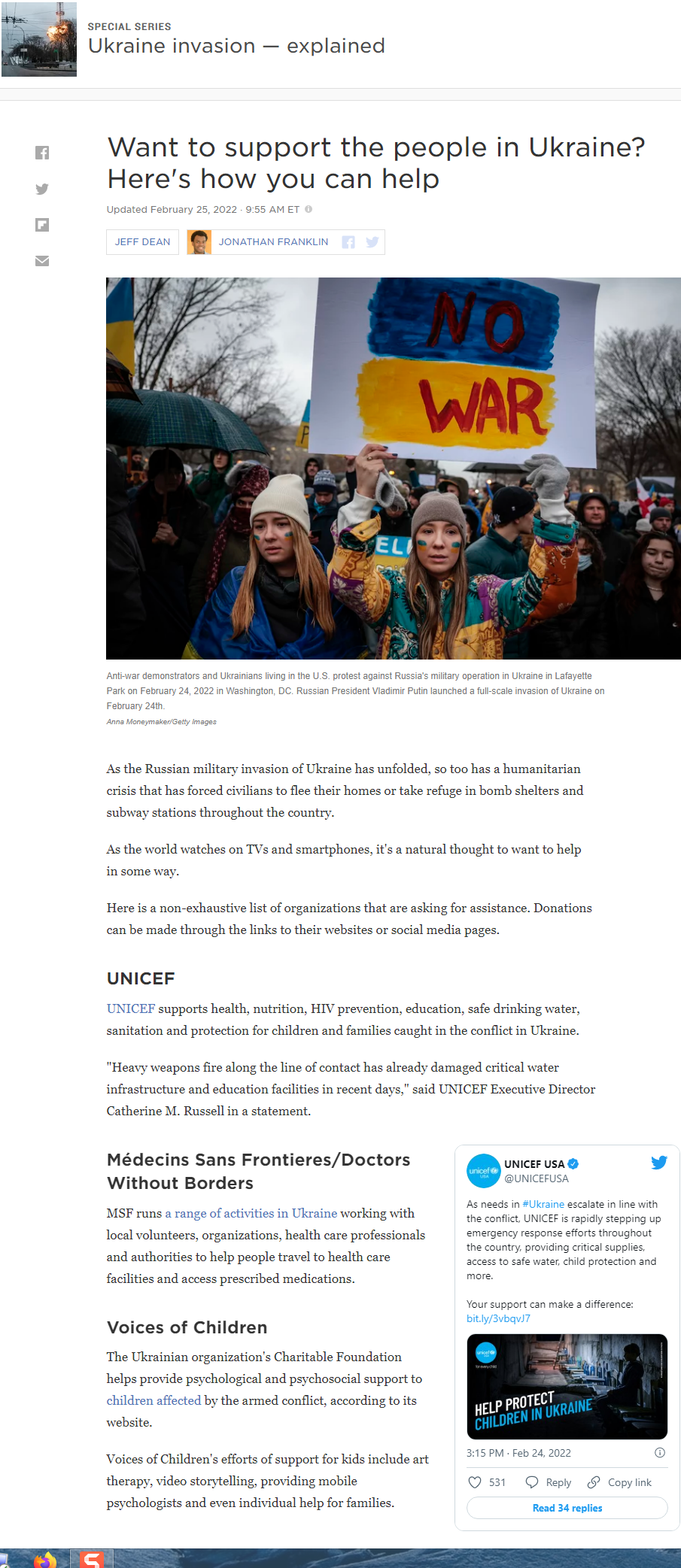
Here is what they get right:
- They remind folks they can always rely on NPR for trusted information – in any crisis.
- They indicate they’re in tune with what their supporters care about in this moment in time.
- They work with member stations to also provide lists and relevant news articles.
Here is a ‘How You Can Help’ list from my local San Francisco station, KQED.

Interestingly, I’ve seen other local non-profits partner with their public television station by sharing this list on their own website. This might be something for you to consider if you’re looking for a quick way to make a statement and show your concern.
What if you’re not a front-line responder?
Are you thinking ‘our non-profit has nothing to do with Ukraine or, for that matter, direct human services?’ That may be true, but you’re still a compassionate, concerned organisation.
Talk about your compassion and concern.
Take this opportunity to show your humanity. Don’t act as if everything is ‘normal,’ because it’s not. And don’t fall into the mistake of cutting back on your messaging because you feel it’s ‘less important’ right now. If it was important before, it’s important today too. And you can bet your donors feel that way.
People won’t likely give you less just because they’re also giving to the crisis of the moment. They’ll simply give more. But… don’t be shy right now. If you want to assure folks’ ‘more’ giving includes staying loyal and generous to your charity, it behoves you to be in contact.
Here’s an example from the San Francisco Ballet Instagram account. It’s a simple demonstration of their concern and solidarity with people everywhere fighting tyranny and oppression.
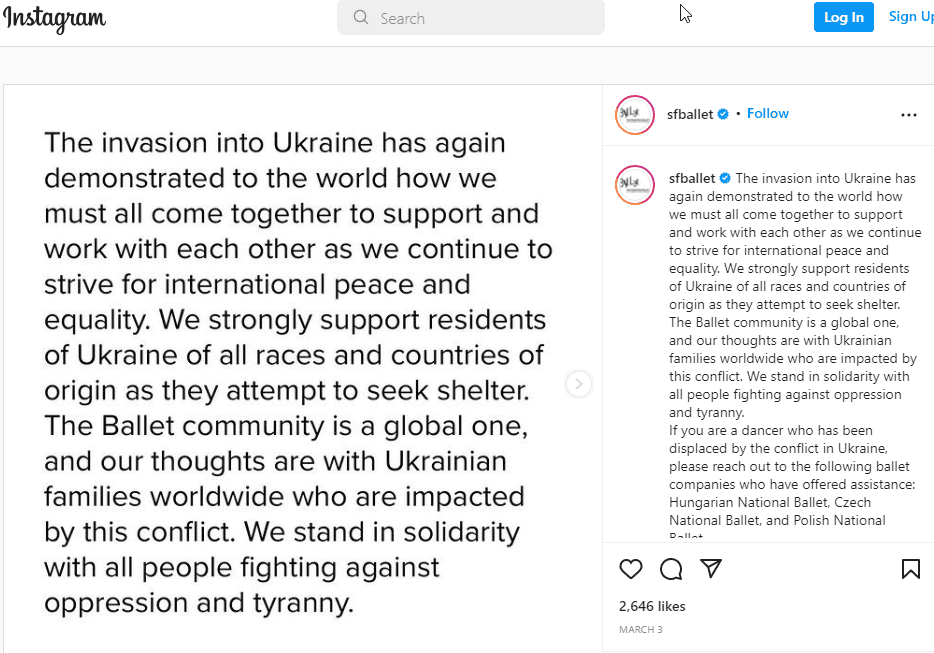
Here is what they get right:
- They include a nod to their mission, indicating to dancers how they can reach out for help in various eastern European countries.
- They remind supporters they’re part of a larger philanthropic community and recognise all are impacted by the conflict. Whenever you can make folks feel a part of something larger than themselves, you’re on your way to fulfilling your role, as a philanthropy facilitator, to make people experience the gentle joy of giving and purpose.
Something else you can do, regardless of your mission, is more symbolic.
- Opera and symphony houses across the world have lit up buildings in the colours of the Ukraine flag.
- Schools have held bake sales (yellow and blue frosted cupcakes) with proceeds going to help UNICEF or other direct service organisations on the ground in Ukraine.
- I attended a rally where they handed out sunflowers with attached cards with QR codes directing folks to make a donation to World Central Kitchen.

- Walking by my local pet store today, I saw a sign saying ‘All proceeds from dog washes donated to World Central Kitchen.’ If you’re an animal rescue or therapy organisation, you could try a similar special benefit event.
Summary
Don’t ignore what’s going on in the world.
If you do, you risk appearing oblivious.
People, and organisations, who bury their heads in the sand aren’t generally looked to as trusted, well-rounded, concerned, and caring citizens.
Be one of the ‘good guys’ whenever you can.
And you always can.
It just takes waking up every day and asking yourself and your team: ‘What can we do today to be of greatest service to our constituents?’
This is one of the things it means to build goodwill and live a true culture of philanthropy.
Go get creative!
















